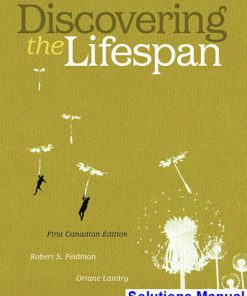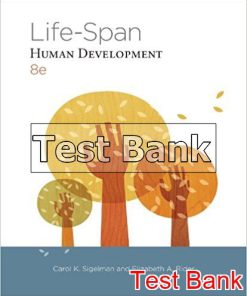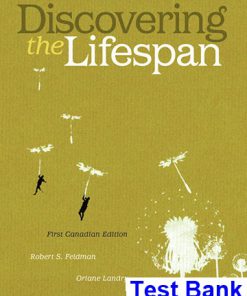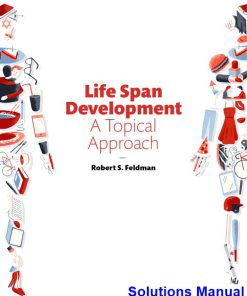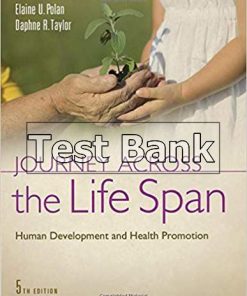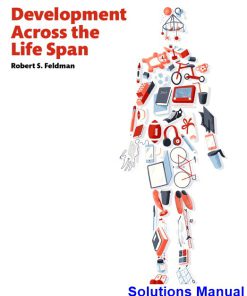Development Across the Life Span 8th Edition Feldman Test Bank
You may also like
Development Across the Life Span 8th Edition Feldman Test Bank

Product details:
- ISBN-10 : 9780134225890
- ISBN-13 : 978-0134225890
- Author: Robert S. Feldman
A compelling blend of lifespan development research and applications
Development Across the Life Span provides a chronological overview of human development from the moment of conception through death, examining both the traditional areas of the field and more recent innovations. Author Robert Feldman focuses on how developmental findings can be can be applied meaningfully and practically, helping students to recognize the relevance of the discipline to their own lives. Thoroughly updated with the latest data and contemporary examples, the Eighth Edition better engages students in key concepts via recent news items, timely world events, and contemporary uses of lifespan development.
Table contents:
PART 1: BEGINNINGS Chapter 1: Beginnings: An Introduction to Development Across the Lifespan 2 Prologue: A Brave New World 3 Looking Ahead 4 AN ORIENTATION TO LIFESPAN DEVELOPMENT 5 Developmental Diversity: How Culture, Ethnicity, and Race Influence Development 11 KEY ISSUES AND QUESTIONS: DETERMINING THE NATURE-AND NURTURE-OF LIFESPAN DEVELOPMENT 12 THEORETICAL PERSPECTIVES ON LIFESPAN DEVELOPMENT 16 RESEARCH METHODS 30 From Research to Practice: Using Developmental Research to Improve Public Policy 37 Becoming an Informed Consumer of Development: Evaluating the "Experts" 41 Epilogue 42 Looking Back 43 Key Terms and Concepts 44 Chapter 2: The Start of Life: Genetics and Prenatal Development 46 Prologue: Multiplicity 47 Looking Ahead 48 EARLIEST DEVELOPMENT 48 THE INTERACTION OF HEREDITY AND ENVIRONMENT 60 From Research to Practice: Advancing Gene Therapy: Are We Heading Toward a Clone Age? 61 Developmental Diversity : Cultural Differences in Physical Arousal: Might a Culture's Philosophical Outlook Be Determined by Genetics? 69 PRENATAL GROWTH AND CHANGE 73 Becoming an Informed Consumer of Development: Optimizing the Prenatal Environment 84 Epilogue 85 Looking Back 86 Key Terms and Concepts 87 Chapter 3: Birth and the Newborn Infant 88 Prologue: A Life Begins Early 89 Looking Ahead 90 BIRTH 90 From Research to Practice: Who Delivers? Childbirth Attendants in the 21st Century 98 Becoming an Informed Consumer of Development: Dealing with Labor 100 BIRTH COMPLICATIONS 101 Careers in Lifespan Development: Diana Hegger, Neonatal Nurse and Educator 106 Developmental Diversity: Overcoming Racial and Cultural Differences in Infant Mortality 108 THE COMPETENT NEWBORN 112 Epilogue 119 Looking Back 120 Key Terms and Concepts 121 PART 2: INFANCY: FORMING THE FOUNDATIONS OF LIFE Chapter 4: Physical Development in Infancy 122 Prologue: First Steps 123 Looking Ahead 124 GROWTH AND STABILITY 124 From Research to Practice: SIDS: The Unanticipated Killer 134 MOTOR DEVELOPMENT 135 Developmental Diversity: The Cultural Dimensions of Motor Development 140 THE DEVELOPMENT OF THE SENSES 147 Becoming an Informed Consumer of Development: Exercising Your Infant's Body and Senses 153 Epilogue 154 Looking Back 154 Key Terms and Concepts 155 Chapter 5: Cognitive Development in Infancy 156 Prologue: The Forgotten Memories of Simona Young 157 Looking Ahead 158 PIAGET'S APPROACH TO COGNITIVE DEVELOPMENT 158 INFORMATION-PROCESSING APPROACHES TO COGNITIVE DEVELOPMENT 167 INDIVIDUAL DIFFERENCES IN INTELLIGENCE: IS ONE INFANT SMARTER THAN ANOTHER? 171 From Research to Practice: Crib TV 176 THE ROOTS OF LANGUAGE 176 Developmental Diversity: Is Infant-Directed Speech Similar Across All Cultures? 184 Becoming an Informed Consumer of Development : What Can You Do to Promote Infants' Cognitive Development? 186 Epilogue 187 Looking Back 188 Key Terms and Concepts 189 Chapter 6: Social and Personality Development in Infancy 190 Prologue: The Velcro Chronicles 191 Looking Ahead 192 FORMING THE ROOTS OF SOCIABILITY 192 FORMING RELATIONSHIPS 200 Developmental Diversity: Does Attachment Differ Across Cultures? 205 DIFFERENCES AMONG INFANTS 209 Becoming an Informed Consumer of Development: Choosing the Right Infant Care Provider 215 From Research to Practice: How Does Infant Childcare Affect Later Development? 216 Epilogue 218 Looking Back 218 Key Terms and Concepts 219 PART 3: THE PRESCHOOL YEARS Chapter 7: Physical and Cognitive Development in the Preschool Years 220 Prologue: Aaron 221 Looking Ahead 222 PHYSICAL GROWTH 222 Becoming an Informed Consumer of Development: Keeping Preschoolers Healthy 233 INTELLECTUAL DEVELOPMENT 235 From Research to Practice: Children's Eyewitness Testimony: Memory on Trial 243 THE GROWTH OF LANGUAGE AND LEARNING 248 Developmental Diversity: Preschools Around the World 255 Careers in Lifespan Development: Robert Recio, Jr., Preschool Teacher 258 Epilogue 259 Looking Back 259 Key Terms and Concepts 261 Chapter 8: Social and Personality Development in the Preschool Years 262 Prologue: The Gathering 263 Looking Ahead 264 FORMING A SENSE OF SELF 264 Developmental Diversity: Developing Racial and Ethnic Awareness 266 FRIENDS AND FAMILY: PRESCHOOLERS' SOCIAL LIVES 272 From Research to Practice: Spanking: Why the Experts Say "No" 282 Becoming an Informed Consumer of Development: Disciplining Children 285 Moral Development and Aggression 286 Becoming an Informed Consumer of Development: Increasing Moral Behavior and Reducing Epilogue 296 Looking Back 297 Key Terms and Concepts 299 PART 4: THE MIDDLE CHILDHOOD YEARS Chapter 9: Physical and Cognitive Development in Middle Childhood 300 Prologue: Suzanne McGuire 301 Looking Ahead 302 PHYSICAL DEVELOPMENT 302 Becoming an Informed Consumer of Development: Keeping Children Fit 314 INTELLECTUAL DEVELOPMENT 316 SCHOOLING: THE THREE Rs (AND MORE) OF MIDDLE CHILDHOOD 325 Developmental Diversity: Multicultural Education 328 From Research to Practice: Home Schooling: Living Rooms as Classrooms 329 Careers in Lifespan Development: Valerie Patterson, Special Education Teacher 343 Epilogue 345 Looking Back 345 Key Terms and Concepts 347 Chapter 10: Social and Personality Development in Middle Childhood 348 Prologue: Balancing Cultures 349 Looking Ahead 350 THE DEVELOPING SELF 350 Developmental Diversity: Are Children of Immigrant Families Well Adjusted? 356 RELATIONSHIPS: BUILDING FRIENDSHIP IN MIDDLE CHILDHOOD 361 From Research to Practice: Stopping the Torment: Dealing with Schoolyard Bullies 367 Becoming an Informed Consumer of Development: Increasing Children's Social Competence 369 FAMILY AND SCHOOL: SHAPING CHILDREN'S BEHAVIOR IN MIDDLE CHILDHOOD 370 Developmental Diversity: Explaining Asian Academic Success 379 Epilogue 384 Looking Back 385 Key Terms and Concepts 387 PART 5: ADOLESCENCE Chapter 11: Physical and Cognitive Development in Adolescence 388 Prologue: Picture of Health 389 Looking Ahead 390 PHYSICAL MATURATION 390 COGNITIVE DEVELOPMENT AND SCHOOLING 400 From Research to Practice: Violence in Schools 410 THREATS TO ADOLESCENTS' WELL-BEING 411 Careers in Lifespan Development: Doreen Gail Branch, Substance Abuse Researcher 413 Becoming an Informed Consumer of Development: Hooked on Drugs or Alcohol? 414 Developmental Diversity: Selling Death: Pushing Smoking to the Less Advantaged 416 Epilogue 419 Looking Back 420 Key Terms and Concepts 421 Chapter 12: Social and Personality Development in Adolescence 422 Prologue: Adolescent Trio 423 Looking Ahead 424 IDENTITY: ASKING "WHO AM I?" 424 Becoming an Informed Consumer of Development: Adolescent Suicide: How to Help 435 RELATIONSHIPS: FAMILY AND FRIENDS 436 Developmental Diversity: Race Segregation: The Great Divide of Adolescence 442 DATING, SEXUAL BEHAVIOR, AND TEENAGE PREGNANCY 447 From Research to Practice: Explaining the Decline in Teen Pregnancy 451 Epilogue 453 Looking Back 454 Key Terms and Concepts 455 PART 6: EARLY ADULTHOOD Chapter 13: Physical and Cognitive Development in Early Adulthood 456 Prologue: A Tale of Two Students 457 Looking Ahead 458 PHYSICAL DEVELOPMENT AND STRESS 458 Developmental Diversity: How Cultural Beliefs Influence Health and Health Care 462 Careers in Lifespan Development: Martin Binks, Behavioral Health Clinician 465 Becoming an Informed Consumer of Development: Coping with Stress 470 COGNITIVE DEVELOPMENT 472 COLLEGE: PURSUING HIGHER EDUCATION 479 Becoming an Informed Consumer of Development: When Do College Students Need Professional Help with Their Problems? 483 From Research to Practice: Stereotype Threat and Disidentification with School: Do Stereotypes Depress the Academic Performance of African-Americans and Women? 487 Epilogue 489 Looking Back 489 Key Terms and Concepts 491 Chapter 14: Social and Personality Development in Early Adulthood 492 Prologue: Dance 493 Looking Ahead 494 FORGING RELATIONSHIPS: INTIMACY, LIKING, AND LOVING DURING EARLY ADULTHOOD 494 Developmental Diversity: Gay and Lesbian Relationships: Men with Men and Women with Women 506 THE COURSE OF RELATIONSHIPS 507 From Research to Practice: Does a Good Marriage Mean a Long Life? The Impact of Marital Quality on Health 511 WORK: CHOOSING AND EMBARKING ON A CAREER 516 Becoming an Informed Consumer of Development: Choosing a Career 521 Epilogue 523 Looking Back 523 Key Terms and Concepts 525 PART 7: MIDDLE ADULTHOOD Chapter 15: Physical and Cognitive Development in Middle Adulthood 526 Prologue: Fit for Life 527 Looking Ahead 528 PHYSICAL DEVELOPMENT 528 From Research to Practice: The Dilemma of Hormone Therapy: No Easy Answer 535 HEALTH 536 Developmental Diversity: Individual Variation in Health: Ethnic and Gender Differences 539 COGNITIVE DEVELOPMENT 547 Becoming an Informed Consumer of Development: Effective Strategies for Remembering 553 Epilogue 554 Looking Back 554 Key Terms and Concepts 557 Chapter 16: Social and Personality Development in Middle Adulthood 558 Prologue: A Winding Journey to Success 559 Looking Ahead 560 PERSONALITY DEVELOPMENT 560 Developmental Diversity: Middle Age: In Some Cultures It Doesn't Exist 564 From Research to Practice From College Yearbook Photo to Midlife Personality: The Stability of Personality in Later Years of Life 567 RELATIONSHIPS: FAMILY IN MIDDLE AGE 568 Becoming an Informed Consumer of Development: Dealing with Spousal Assault 577 WORK AND LEISURE 579 Careers in Lifespan Development: Cathy Goodwin, Career Advisor 582 Developmental Diversity: Immigrants on the Job: Making It in America 582 Epilogue 586 Looking Back 587 Key Terms and Concepts 589 PART 8: LATE ADULTHOOD Chapter 17: Physical and Cognitive Development in Late Adulthood 590 Prologue: 100 and Counting 591 Looking Ahead 592 PHYSICAL DEVELOPMENT IN LATE ADULTHOOD 593 HEALTH AND WELLNESS IN LATE ADULTHOOD 601 Becoming an Informed Consumer of Development: Caring for People with Alzheimer's Disease 605 From Research to Practice: Will Your Attitude Toward Aging Affect Your Life Span? 606 Developmental Diversity: Gender, Race, and Ethnic Differences in Average Life Expectancy: Separate Lives, Separate Deaths 612 COGNITIVE DEVELOPMENT IN LATE ADULTHOOD 614 Epilogue 619 Looking Back 620 Key Terms and Concepts 621 Chapter 18: Social and Personality Development in Late Adulthood 622 Prologue: Sex, Love, and Nursing Homes 623 Looking Ahead 624 PERSONALITY DEVELOPMENT AND SUCCESSFUL AGING 624 Developmental Diversity: How Culture Shapes the Way We Treat People in Late Adulthood 630 THE DAILY LIFE OF LATE ADULTHOOD 636 Becoming an Informed Consumer of Development: Planning For-and Living-a Good Retirement 642 RELATIONSHIPS: OLD AND NEW 643 From Research to Practice: Life After Death: Adjusting to the Loss of a Spouse 648 Epilogue 653 Looking Back 653 Key Terms and Concepts 655 PART 9: ENDINGS Chapter 19: Endings: Death and Dying 656 Prologue: Choosing Death 657 Looking Ahead 658 DYING AND DEATH ACROSS THE LIFESPAN 658 Developmental Diversity: Differing Conceptions of Death 663 CONFRONTING DEATH 666 From Research to Practice: Comfort for the Dying: Palliative Care as an Alternative to Aggressive Treatment 673 Careers in Lifespan Development: Dina C. Bianga, Hospice Nurse 675 GRIEF AND BEREAVEMENT 675 Becoming an Informed Consumer of Development: Helping a Child Cope with Grief 679 Epilogue 680 Looking Back 680 Key Terms and Concepts 681 Glossary References Acknowledgments Name Index Subject Index Preface This book tells a story: the story of our lives, and our parents' lives, and the lives of our children. It is the story of human beings and how they get to be the way they are. Unlike any other area of study, lifespan development speaks to us in a very personal sense. It covers the range of human existence from its beginnings at conception to its inevitable ending at death. It is a discipline that deals with ideas and concepts and theories, but one that above all has at its heart people-our fathers and mothers, our friends and acquaintances, our very selves. Development Across the Life Span seeks to capture the discipline in a way that sparks and nurtures and shapes readers' interest. It is meant to excite students about the field, to draw them into its way of looking at the world, and to build their understanding of developmental issues. By exposing readers to both the current content and the promise inherent in lifespan development, the text is designed to keep interest in the discipline alive long after students' formal study of the field has ended. Overview of the Fourth Edition Development Across the Life Span, Fourth Edition-like its predecessors-provides a broad overview of the field of human development. It covers the entire range of the human life, from the moment of conception through death. The text furnishes a broad, comprehensive introduction to the field, covering basic theories and research findings, as well as highlighting current applications outside the laboratory. It covers the life span chronologically, encompassing the prenatal period, infancy and toddlerhood, the preschool years, middle childhood, adolescence, early and middle adulthood, and late adulthood. Within these periods, it focuses on physical, cognitive, and social and personality development. The book seeks to accomplish the following four major goals: * First and foremost, the book is designed to provide a broad, balanced overview of the field of lifespan development. It introduces readers to the theories, research, and applications that constitute the discipline, examining both the traditional areas of the field as well as more recent innovations. It pays particular attention to the applications developed by lifespan development specialists, demonstrating how lifespan developmentalists use theory, research, and applications to help solve significant social problems. * The second goal of the text is to explicitly tie development to students' lives. Findings from the study of lifespan development have a significant degree of relevance to students, and this text illustrates how these findings can be applied in a meaningful, practical sense. Applications are presented in a contemporaneous framework, including current news items, timely world events, and contemporary uses of lifespan development that draw readers into the field. Numerous descriptive scenarios and vignettes reflect everyday situations in people's lives, explaining how they relate to the field. * The third goal is to highlight both the commonalities and diversity of today's multicultural society. Consequently, the book incorporates material relevant to diversity in all its forms-racial, ethnic, gender, sexual orientation, religion, and cultural diversity-throughout every chapter. In addition, every chapter has at least one "Developmental Diversity" section. These features explicitly consider how cultural factors relevant to development both unite and diversify our contemporary, global society. * Finally, the fourth goal is one that is implicit in the other three: making the field of lifespan development engaging, accessible, and interesting to students. Lifespan development is a joy both to study and teach, because so much of it has direct, immediate meaning to our lives. Because all of us are involved in our own developmental paths, we are tied in very personal ways to the content areas covered by the book. Development Across the Life Span, then, is meant to engage and nurture this interest, planting a seed that will develop and flourish throughout readers' lifetimes. In accomplishing these goals, the book strives to be user-friendly. Written in a direct, conversational voice, it replicates as much as possible a dialogue between author and student. The text is meant to be understood and mastered on its own by students of every level of interest and motivation. To that end, it includes a variety of pedagogical features that promote mastery of the material and encourage critical thinking. In short, the book blends and integrates theory, research, and applications, focusing on the breadth of human development. Furthermore, rather than attempting to provide a detailed historical record of the field, it focuses on the here-and-now, drawing on the past where appropriate, but with a view toward delineating the field as it now stands and the directions toward which it is evolving. Similarly, while providing descriptions of classic studies, the emphasis is more on current research findings and trends. Development Across the Life Span is meant to be a book that readers will want to keep in their own personal libraries, one that they will take off the shelf when considering problems related to that most intriguing of questions: How do people come to be the way they are? What's New in the Fourth Edition? The fourth edition of Development Across the Life Span has been extensively revised in response to the comments of dozens of reviewers. Among the major changes are the following: Additions of New and Updated Material The revision incorporates a significant amount of new and updated information. For instance, advances in such areas as behavioral genetics, brain development, evolutionary perspectives, and cross-cultural approaches to development receive expanded and new coverage. Overall, more than a thousand new citations have been added, with most of those from articles and books published in the last three years. New topics were added to every chapter. The following sample of new and revised topics featured in this edition provides a good indication of the currency of the revision: Chapter 1 Cognitive neuroscience Gain and loss principles Social construction Neo-Piagetian approaches Chapter 2 Sex selection Turner's syndrome Gene therapy Infertility findings Intrafallopian transfer (GIFT) Zygote intrafallopian transfer (ZIFT) Chapter 3 Post-partum depressionDoula Chapter 4 Cross-national data on breast-feeding Dynamic systems theory SIDS Chapter 5 Neuroscience of memory Autobiographical memory in infants Television viewing in infancy Chapter 6 Brain development and emotions MAX-facial expressions in infants Child care effects Biological bases of temperament Chapter 7 False memories/abuse Memory and culture Vygotsky and gender roles APA recommendations on restricting advertising targeting children Chapter 8 Relational and instrumental aggression Limbic system changes due to abuse Spanking Video games and aggression Autism and theory of mind False belief task and theory of mind Chapter 9 New conclusions regarding teaching of reading Safety in cyberspace Culture and growth Psychological disorders Home schooling Chapter 10 Self-esteem and race Bullying Children of gay and lesbian parents Measurement of status Families and race Chapter 11 Myelination and gray matter Exercise, obesity, and race School violence School dropout rate Addiction Chapter 12 MAMA cycle Gender differences in self-esteem Explaining the decline in teen pregnancy Bisexuality Transgenderism Chapter 13 Disidentification with school Coping Psychological problems of college students Sinnott's work on postformal thought Maturational reform hypothesis Chapter 14 Health benefits of marriage Cohabitation Gay and lesbian marriage Chapter 15 Erectile dysfunction and treatment Hormone therapy Chapter 16 Immigrants Cultural views of middle age Caregiving to older generation Stability of personality Chapter 17 Psychological disorders in late adulthood AIDS Relationship of exercise and brain development Attitudes toward aging and length of life Chapter 18 Job discrimination Positive emotions Emotion regulation Internet dating Adjustment to widowhood Chapter 19 Palliative care Native American conceptions of death Oregon assisted suicide law Revisions to Foster Student Critical Thinking and Mastery of the Material In order to help students master the material and think critically about it, a number of subtle changes were made to this edition to reinforce the existing features: * Critical thinking questions in From Research to Practice boxes. Two critical thinking questions were added at the end of each box, helping students to think more deeply about the material and to make connections between the material in the box and students' lives. * Review and Apply questions. Interspersed throughout each chapter are several short recaps of the chapters' main points, followed by questions designed to provoke critical thinking and applications of the material to child development. In this edition, at least one question asks readers to take the perspective of someone working in an occupation that relies on findings of lifespan development, including the fields of health care, education, and social work. Ancillaries Development Across the Life Span, Fourth Edition is accompanied by a superb set of teaching and learning materials. For the Instructor: [To come from PH]. [COMP: LEAVE MIN. 1 PAGE FOR THIS MISSING TEXT] For the Student: [To come from PH]. [COMP: LEAVE 1 PAGE FOR THIS MISSING TEXT] Acknowledgments I am grateful to the following reviewers who provided a wealth of comments, constructive criticism, and encouragement: [List of Reviewers' to come from PH.] [COMP: LEAVE 12 PICAS SPACE FOR THIS MISSING TEXT] Many others deserve a great deal of thanks. I am indebted to the many people who provided me with a superb education, first at Wesleyan University and later at the University of Wisconsin. Specifically, Karl Scheibe played a pivotal role in my undergraduate education, and the late Vernon Allen acted as mentor and guide through my graduate years. It was in graduate school that I learned about development, being exposed to such experts as Ross Parke, John Balling, Joel Levin, Herb Klausmeier, and many others. My education continued when I became a professor. I am especially grateful to my colleagues at the University of Massachusetts, who make the university such a wonderful place in which to teach and do research. Several people played central roles in the development of this book. Edward Murphy brought a keen intelligence and editorial eye to the process. John Bickford provided research assistance, and I am thankful for his help. Most of all, John Graiff was essential in juggling and coordinating the multiple aspects of writing a book, and I am very grateful for the substantial role he played. I am also grateful to the superb Prentice Hall team that was instrumental in the inception and development of this book. Jennifer Gilliland, Senior Editor, vigilantly watched over the project, demonstrating a rare level of insight and creativity. Stephanie Johnson coordinated the editorial process, and Leah Jewell stood behind the project. I am grateful for their support. Leslie Carr, development editor, provided a wealth of valuable input, and the book is much improved by her thoughtful contributions. On the production end of things, xxxx xxxxxxxxx, the production supervisor, and xxxxxx xxxxxxxx, photo editor, helped in giving the book its distinctive look. Finally, I'd like to thank (in advance) marketing manager xxxxxxx xxxxxxxxx, on whose skills I'm counting. I also wish to acknowledge the members of my family, who play such a pivotal role in my life. My brother, Michael, my sisters-in-law and brother-in-law, my nieces and nephews, all make up an important part of my life. In addition, I am always indebted to the older generation of my family, who led the way in a manner I can only hope to emulate. I will always be obligated to Ethel Radler, Harry Brochstein, and the late Mary Vorwerk. Most of all, the list is headed by my father, the late Saul Feldman, and my mother, Leah Brochstein. In the end, it is my immediate family who deserve the greatest thanks. My terrific kids, Jonathan (and his wife, Leigh), Joshua, and Sarah, not only are nice, smart, and good-looking, but my pride and joy. And ultimately my wife, Katherine Vorwerk, provides the love and grounding that makes everything worthwhile. I thank them, with all my love. Robert S. Feldman University of Massachusetts at Amherst About the Author Robert S. Feldman is professor of psychology at the University of Massachusetts at Amherst, where he is Director of Undergraduate Studies and recipient of the College Distinguished Teacher Award. He is both a Hewlett Teaching Fellow and a Senior Online Teaching Fellow at UMass. Professor Feldman was educated as an undergraduate at Wesleyan University, from which he graduated with High Honors, and received a M.S. and Ph.D. from the University of Wisconsin-Madison, where he specialized in social and developmental psychology. Among his more than 100 books, chapters, and articles, he has edited Development of Nonverbal Behavior in Children (Springer-Verlag), Applications of Nonverbal Behavioral Theory and Research (Erlbaum), and co-edited Fundamentals of Nonverbal Behavior (Cambridge University Press). He is the recipient of grants from the National Institute of Mental Health and the National Institute of the Disabilities and Rehabilitation Research, which have supported his research on the development of nonverbal behavior in children. A past Fulbright lecturer and research scholar, he is a Fellow of the American Psychological Association and American Psychological Society. During the course of nearly two decades as a college instructor, he has taught both undergraduate and graduate courses at Mount Holyoke College, Wesleyan University, Virginia Commonwealth University, in addition to the University of Massachusetts. Professor Feldman loves music, is an enthusiastic pianist, and is an excellent cook. He has three children, and he and his wife, a psychologist, live in Amherst, Massachusetts, in a home overlooking the Holyoke mountain range. Special Features Development Across the Life Span, Fourth Edition CHAPTER-OPENING PROLOGUES Each chapter begins with a short vignette, describing an individual or situation that is relevant to the basic developmental issues being addressed in the chapter. For instance, the chapter on birth describes a premature birth; one of the chapters on adolescence provides accounts of three teenagers; and a chapter on late adulthood discusses turning 100. [Insert Prologue examples here] [COMP: LEAVE 20 PICAS SPACE] LOOKING AHEAD SECTIONS These opening sections orient readers to the topics to be covered, bridging the opening prologue with the remainder of the chapter and providing orienting questions. [Insert Looking Ahead example here] [COMP: LEAVE 12 PICAS SPACE] FROM RESEARCH TO PRACTICE Each chapter includes a section that describes current developmental research or research issues, applied to everyday problems. For instance, these sections include discussions of the use spanking, stereotypes and academic performance of women and African Americans, and comforting the dying. [Insert From Research to Practice example here] [COMP: LEAVE 12 PICAS SPACE] DEVELOPMENTAL DIVERSITY Every chapter has at least one "Developmental Diversity" section incorporated into the text. These sections highlight issues relevant to today's multicultural society. Examples of these sections include discussions preschools around the world, gay and lesbian relationships, the marketing of cigarettes to the less advantaged, and race, gender, and ethnic differences in life expectancy. [Insert Developmental Diversity example here] [COMP: LEAVE 12 PICAS SPACE] BECOMING AN INFORMED CONSUMER OF DEVELOPMENT Every chapter includes information on specific uses that can be derived from research conducted by developmental investigators. For instance, the text provides concrete information on how to encourage children to become more physically active, help troubled adolescents who might be contemplating suicide, and planning and living a good retirement. [Insert Becoming an Informed Consumer example here] [COMP: LEAVE 12 PICAS SPACE] CAREERS IN LIFESPAN DEVELOPMENT Many chapters include an interview with a person working in a field that uses the findings of lifespan development. Among those interviewed are a toy designer, career advisor, and hospice nurse. [Insert Careers example here] [COMP: LEAVE 16 PICAS SPACE] REVIEW AND APPLY SECTIONS Interspersed throughout each chapter are three short recaps of the chapters' main points, followed by questions designed to provoke critical thinking. [Insert Review and Apply example here] [COMP: LEAVE 12 PICAS SPACE] RUNNING GLOSSARY Key terms are defined in the margins of the page on which the term is presented. [Insert Running Glossary example here] [COMP: LEAVE 12 PICAS SPACE] END-OF-CHAPTER MATERIAL Each chapter ends with an Epilogue that refers back to the opening Prologue, a numbered summary, and a list of key terms and concepts. This material is designed to help students study and retain the information in the chapter. [Insert Epilogue example here] [COMP: LEAVE 16 PICAS SPACE] [COMP: FRONTMATTER ENDS]
People also search:
development across the life span 8th edition
development across the life span
8 life-span developmental periods
development across the lifespan 8th edition
development across the lifespan 8th edition pdf free
development across the lifespan quizlet

